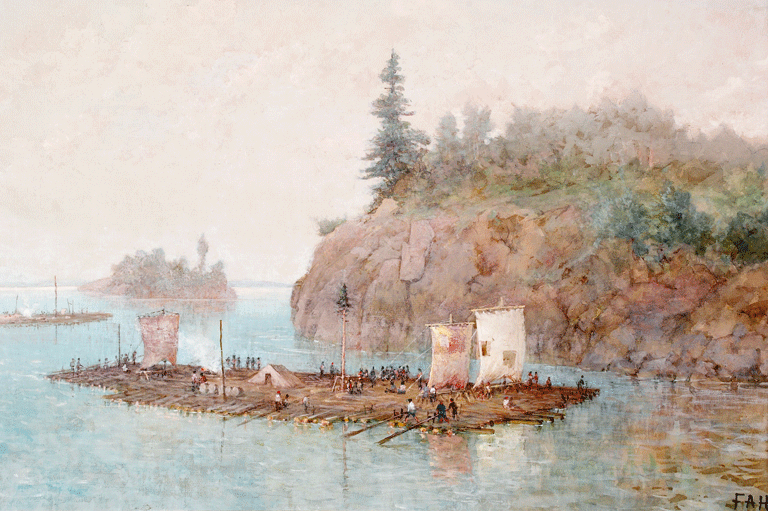1764: An Enduring Relationship
Grade Levels: 7/8, 9/10. 11/12
Subject Area: Social Studies, History, Geography
This lesson is based on the article “Ties of Kinship” written by Philip Cote and Nathan Tidridge in the Treaties and the Treaty Relationship issue of Canada's History magazine.
Lesson Overview
In this lesson students explore the Treaty of Niagara as a foundational relationship in the creation of Canada. They investigate how this familial relationship, created by Treaty, was meant to be the foundation for the interactions between First Nations and non-First Nations.
Time Required
One class period
Historical Thinking Concept(s)
- Establish historical significance
- Use primary source evidence
- Take historical perspectives
Learning Outcomes
Students will:
- Recognize that a Treaty is a relationship.
- Recognize and appreciate that the Crown is bound in family relationships with First Nations.
- Explore the historiography concerning the founding of Canada.
The Lesson Activity
Activating: How will students be prepared for learning?
- Pass out copies of the lesson’s BLMs to the class:
- Give the students several minutes to investigate and share the images/primary sources.
- Collect the images. Open the floor to questions.
- Place sticky tack on the back of each BLM.
- Invite a student to come to the front of the class and affix the documents in chronological order. Guide and assist as necessary. [Wampum Belt, BNA Act, Indian Act]
- Open the class to questions and discussion.
- Repeat the activity with following criteria, places the documents in order based on:
- Order of national importance [This is an opinion]
- Order of long-term or enduring importance [This is an opinion]
- Explain that history consists of facts and opinions and that historians have their own perspectives when assigning significance to an event or person.
- Affix BLM #7.1: British North America Act, 1867. Explain that historians have typically marked Confederation and the BNA Act as the point of beginning for the modern county of Canada. Explain that they will be exploring another starting point: The Treaty of Niagara, 1764.
Acquiring: What strategies facilitate learning for groups and individuals?
- Pass out several copies of the Treaties and the Treaty Relationship issue of Canada’s History magazine and instruct students to read the article “Ties of Kinship” (page 23-25).
- Write the word “CONTRACT” on the board at the front of the room.
- Ask students to brainstorm (individually or in groups) words that come to mind when they think of a contract. (To help them get started it helps to ask them for examples of contracts that they might be familiar with i.e. cellphone contracts).
- Invite students to write words around “CONTRACT” at the front of the room. Some common words/phrases include: signed, written, law, money, penalty, lawyers, fees, long, hard to read, legal, legalese, official and strict.
- Explain that Treaties were never meant to be thought of as contracts, but rather as relationships. Cross out “CONTRACT” and replace it with “RELATIONSHIP.”
- Ask students to think of their closest relationships (family or best friends) and see if the words they came up with to describe a contract still work?
- Brainstorm (individually or in groups) words that come to mind when they think of a strong relationship before writing them at the front of the room. Some common words/phrases include: communication, trust, support, friendship, loyalty, dependability and love (if students don’t come up with love on their own, it is important that this is added to the list by the teacher).
- The love that is often understood is that felt between members of a family – allowing for disagreement and tension. Familial relationships require flexibility to exist. As new dynamics or unforeseen conflicts emerge, they have to be negotiated by the Treaty partners in order to have them incorporated into the relationship (a relatable example often given to students is their own relationships with their siblings – often chaotic, but with a foundation of love at their core).
- Explain that since Treaties are made between the Queen/Crown and First Nation peoples, the Queen and her representatives are often seen as being in family relationships with First Nations
- Encourage questions. Check for understanding.
Applying: How will students demonstrate their understanding?
- Read the excerpt from the article on page 23:
Until recently, both Confederation and the Indian Act that flowed from it eclipsed most of the Treaty relationships in the minds of the non-Indigenous population of Canada. Today the country finds itself returning to the Treaties and rekindling the relationships that sustained the many peoples on these lands for centuries prior to 1867.
Part of this national introspection is the rediscovery by non-Indigenous peoples of the ancient and enduring relationships between First Nations and the sovereign that were enshrined in such Treaties as the 1764 Treaty of Niagara.
- Lead a guided discussion.
- Hand out copies of BLM #7.4.
- Instruct them to complete. Guide and assist as necessary.
Materials/Resources
- Copy/copies of the Treaties and the Treaty Relationship issue of Canada’s History magazine (enough for students to read article)
- Printed copies of BLM #7.1, BLM #7.2, BLM #7.3 – one each
- Printed copies of BLM #7.4 – one per student
- Sticky tack
Extension Activity
Research and collect historical and modern images that reflect Treaties as relationship.
Lesson Plans
Themes associated with this article
Advertisement
Adaptations for grades 3-6

Encouraging a deeper knowledge of history and Indigenous Peoples in Canada.
The Government of Canada creates opportunities to explore and share Canadian history.

The Winnipeg Foundation — supporting our shared truth and reconciliation journey.

We contribute to the well-being of the communities we serve through grants, scholarships, sponsorships, fundraising, volunteering and collaborative relationships with community partners.














